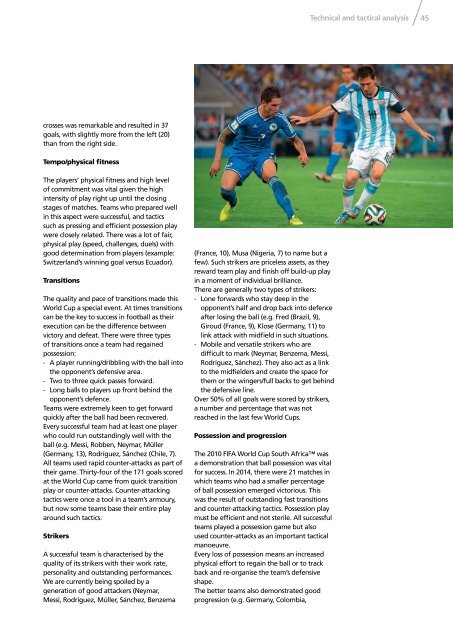2014fwc_tsg_report_15082014_neutral
2014fwc_tsg_report_15082014_neutral
2014fwc_tsg_report_15082014_neutral
You also want an ePaper? Increase the reach of your titles
YUMPU automatically turns print PDFs into web optimized ePapers that Google loves.
Technical and tactical analysis 45<br />
crosses was remarkable and resulted in 37<br />
goals, with slightly more from the left (20)<br />
than from the right side.<br />
Tempo/physical fitness<br />
The players’ physical fitness and high level<br />
of commitment was vital given the high<br />
intensity of play right up until the closing<br />
stages of matches. Teams who prepared well<br />
in this aspect were successful, and tactics<br />
such as pressing and efficient possession play<br />
were closely related. There was a lot of fair,<br />
physical play (speed, challenges, duels) with<br />
good determination from players (example:<br />
Switzerland’s winning goal versus Ecuador).<br />
Transitions<br />
The quality and pace of transitions made this<br />
World Cup a special event. At times transitions<br />
can be the key to success in football as their<br />
execution can be the difference between<br />
victory and defeat. There were three types<br />
of transitions once a team had regained<br />
possession:<br />
- A player running/dribbling with the ball into<br />
the opponent’s defensive area.<br />
- Two to three quick passes forward.<br />
- Long balls to players up front behind the<br />
opponent’s defence.<br />
Teams were extremely keen to get forward<br />
quickly after the ball had been recovered.<br />
Every successful team had at least one player<br />
who could run outstandingly well with the<br />
ball (e.g. Messi, Robben, Neymar, Müller<br />
(Germany, 13), Rodríguez, Sánchez (Chile, 7).<br />
All teams used rapid counter-attacks as part of<br />
their game. Thirty-four of the 171 goals scored<br />
at the World Cup came from quick transition<br />
play or counter-attacks. Counter-attacking<br />
tactics were once a tool in a team’s armoury,<br />
but now some teams base their entire play<br />
around such tactics.<br />
Strikers<br />
A successful team is characterised by the<br />
quality of its strikers with their work rate,<br />
personality and outstanding performances.<br />
We are currently being spoiled by a<br />
generation of good attackers (Neymar,<br />
Messi, Rodríguez, Müller, Sánchez, Benzema<br />
(France, 10), Musa (Nigeria, 7) to name but a<br />
few). Such strikers are priceless assets, as they<br />
reward team play and finish off build-up play<br />
in a moment of individual brilliance.<br />
There are generally two types of strikers:<br />
- Lone forwards who stay deep in the<br />
opponent’s half and drop back into defence<br />
after losing the ball (e.g. Fred (Brazil, 9),<br />
Giroud (France, 9), Klose (Germany, 11) to<br />
link attack with midfield in such situations.<br />
- Mobile and versatile strikers who are<br />
difficult to mark (Neymar, Benzema, Messi,<br />
Rodríguez, Sánchez). They also act as a link<br />
to the midfielders and create the space for<br />
them or the wingers/full backs to get behind<br />
the defensive line.<br />
Over 50% of all goals were scored by strikers,<br />
a number and percentage that was not<br />
reached in the last few World Cups.<br />
Possession and progression<br />
The 2010 FIFA World Cup South Africa was<br />
a demonstration that ball possession was vital<br />
for success. In 2014, there were 21 matches in<br />
which teams who had a smaller percentage<br />
of ball possession emerged victorious. This<br />
was the result of outstanding fast transitions<br />
and counter-attacking tactics. Possession play<br />
must be efficient and not sterile. All successful<br />
teams played a possession game but also<br />
used counter-attacks as an important tactical<br />
manoeuvre.<br />
Every loss of possession means an increased<br />
physical effort to regain the ball or to track<br />
back and re-organise the team’s defensive<br />
shape.<br />
The better teams also demonstrated good<br />
progression (e.g. Germany, Colombia,


